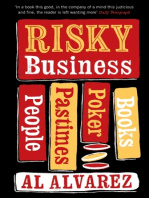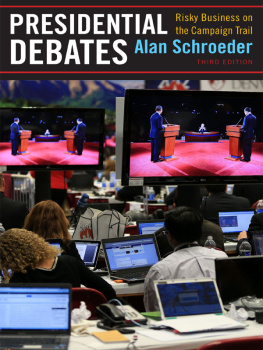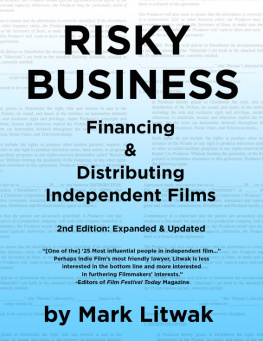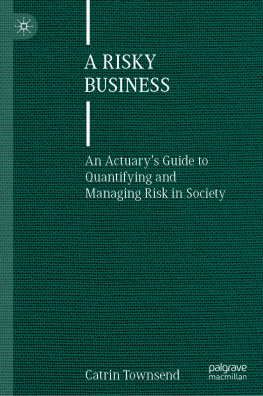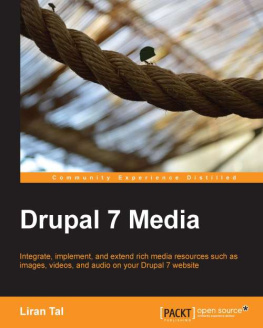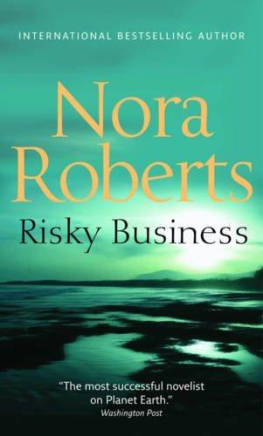Liran Einav - Risky Business
Here you can read online Liran Einav - Risky Business full text of the book (entire story) in english for free. Download pdf and epub, get meaning, cover and reviews about this ebook. year: 2022, publisher: Yale University Press, genre: Business. Description of the work, (preface) as well as reviews are available. Best literature library LitArk.com created for fans of good reading and offers a wide selection of genres:
Romance novel
Science fiction
Adventure
Detective
Science
History
Home and family
Prose
Art
Politics
Computer
Non-fiction
Religion
Business
Children
Humor
Choose a favorite category and find really read worthwhile books. Enjoy immersion in the world of imagination, feel the emotions of the characters or learn something new for yourself, make an fascinating discovery.

- Book:Risky Business
- Author:
- Publisher:Yale University Press
- Genre:
- Year:2022
- Rating:3 / 5
- Favourites:Add to favourites
- Your mark:
- 60
- 1
- 2
- 3
- 4
- 5
Risky Business: summary, description and annotation
We offer to read an annotation, description, summary or preface (depends on what the author of the book "Risky Business" wrote himself). If you haven't found the necessary information about the book — write in the comments, we will try to find it.
Risky Business — read online for free the complete book (whole text) full work
Below is the text of the book, divided by pages. System saving the place of the last page read, allows you to conveniently read the book "Risky Business" online for free, without having to search again every time where you left off. Put a bookmark, and you can go to the page where you finished reading at any time.
Font size:
Interval:
Bookmark:
RISKY BUSINESS
RISKY BUSINESS
Why Insurance Markets Fail and What to Do About It
Liran Einav, Amy Finkelstein, and Ray Fisman

Published with assistance from the Louis Stern Memorial Fund.
Copyright 2022 by Liran Einav, Amy Finkelstein, and Ray Fisman.
All rights reserved.
This book may not be reproduced, in whole or in part, including illustrations, in any form (beyond that copying permitted by Sections 107 and 108 of the U.S. Copyright Law and except by reviewers for the public press), without written permission from the publishers.
Yale University Press books may be purchased in quantity for educational, business, or promotional use. For information, please e-mail (U.K. office).
Set in Yale and Alternate Gothic type by Integrated Publishing Solutions.
Library of Congress Control Number: 2022934606
ISBN 978-0-300-25343-6 (hardcover : alk. paper)
A catalogue record for this book is available from the British Library.
This paper meets the requirements of ANSI/NISO Z39.48-1992 (Permanence of Paper).
This book benefited greatly from a number of generous friends, family members, and colleagues who read the draft. All three of our fathersRoni Einav, Alan Finkelstein, and Michael Fismanread early drafts and provided extensive comments as well as useful insights into how real people (or at least noneconomists) think. In addition, Gill Bejerano, Todd Fitch, Annabella Gong, Gail Marcus, Ben Olken, Maura ONeill, Emily Oster, Jim Poterba, and Gina Wilson all provided extensive comments on the entire draft, sometimes multiple times.
We are also grateful to the following people who provided key feedback on specific parts of the draft: Ran Abramitzky, George Akerlof, Colleen Carey, Nathan Hendren, Damon Jones, Julian Reif, Steve Shebik, David Stuewe, and Mark Vonnahme.
We are enormously grateful to Connie Xu for her extraordinary research assistance. Connie was there from the very beginning and continued helping us even after she went from being an RA to a full-time PhD student. Her ability to take our vague requests and musings, dig into a topic, and return with both essential background information and delightful nuggets that fed directly into our book was invaluable. Her constant good cheer and (purported) enthusiasm for every request we threw at herfrom automobile insurance mandates to tontines to genetic-testing regulation to pet health insurancewas also much appreciated. This book truly would not have been the same without her.
Finally, we would each like to acknowledge our families, albeit in different ways. Ray would like to thankand apologize tohis wife and children, who have suffered through countless dinnertime conversations during which he recounted the many fascinating insurance-related facts and stories that fill this book. Amy is grateful to her husband, Ben, who, despite being a bad insurance customer (see ), has been a steadfast source of support and sage advice ever since he won her heart on their first date by commenting on the selection properties of the credit card he used to pay for (his portion of) their meal. Liran is still in the process of trying to convince his wife and kids that insurance is much more interesting than brown socks (see the Prologue).
Back in 1981, American Airlines had what seemed like the bright idea of locking in its most loyal customers by offering a mileage pass that guaranteed unlimited first-class travel for life. The price: a quarter of a million dollars. (After accounting for inflation, that would be about three-quarters of a million today). It was like a day-pass wristband at an amusement park versus pay-per-ride, only for a lifetime of free cocktails and lie-flat seats, waited on (this being the 1980s) by an army of shoulder-padded, spiral-permed flight attendants.
The company presumed that its new AAirpass would appeal to the business and professional person like the George Clooney character in Up in the Air whose work life revolves around airports and company site visits. The plan made no sense for leisure travelers, according to Americans president at the time, Robert Crandall.
Crandall later admitted that when it came to the AAirpass, it soon became apparent that the public was smarter than we were. One AAirpass holder booked a Nova ScotiaNew YorkMiamiLondonLos AngelesMaineDenverFort Lauderdale vacation in a single July, visiting several of the destinations multiple times during the one-month trip. Another customer took sixteen round-trip flights from Chicago to London in less than a month. Particularly on heavily booked routes like ChicagoLondon, AAirpass holders were taking seats that would otherwise be filled by paying customersthe sixteen ChicagoLondon flights alone would have cost $125,000 if theyd been ticketed.
The AAirpass was turning into an expensive proposition. So American did what you might expect and raised the price to cover itsahemsky-high costs. By 1990, the AAirpass price had gone from $250,000 to $600,000. That only made the problem worse. Now only those who were truly committed to an airborne existence were willing to shell out for the pass, and the cost to American of serving the customers who were still interested in AAirpass rose faster than its price. The price topped a million dollars just three years later; by 1994, American cut its losses and canceled the program.
American learned the hard way that the customers who are willing to pay the most are sometimes the ones you want the least. Thats too bad for American but great for us, as it provides a view from twenty thousand feet (so to speak) of how private information can lead to the slow-motion collapse of a market. It also shows how even savvy businesspeoplelike the president of American Airlinescan fail to anticipate this breakdown of the market. What Crandall failed to appreciate was that most of the people who are willing to shell out $250,000 for unlimited first-class flights belong to that rare breed of traveler who will flyand fly constantlyfor the sheer joy of it.
You may not shed any tears for American Airlines shareholders who lost money off this debacle or care much that AAirpass folded after a decade-long run of losses. But it is just one example of a much larger problem, one that afflicts any market in which sellers care not just about how much they sell but also about whom they are selling to. We call these selection markets, because sellers care about which customers select their products.
About a decade before American Airlines launched its ill-fated AAirpass, the future Nobel Laureate economist George Akerlof effectively foretold its demise. He laid out the basic framework for how private informationwhat a buyer knows that a seller doesnt, or vice versacan destroy a market. His twelve-page argument appeared in a 1970 article titled The Market for Lemons. Like many important ideas in economics, it is at heart fairly straightforward and is well illustrated by many simple, real-life examples, the AAirpass among them. A business unwittingly attracts customers whounbeknownst to the sellerturn out to be expensive to serve. The company is forced to raise prices to cover its unexpectedly high costs, which in turn weeds out all but the most expensive customers. And so it goes, with ever-higher prices attracting an ever-worse pool of customers, which demands yet higher prices still, until the market collapses completely. This powerful insight won Akerlof a Nobel Prize in 2001 and launched the field of information economics that in turn is the foundation for our book.
Next pageFont size:
Interval:
Bookmark:
Similar books «Risky Business»
Look at similar books to Risky Business. We have selected literature similar in name and meaning in the hope of providing readers with more options to find new, interesting, not yet read works.
Discussion, reviews of the book Risky Business and just readers' own opinions. Leave your comments, write what you think about the work, its meaning or the main characters. Specify what exactly you liked and what you didn't like, and why you think so.

